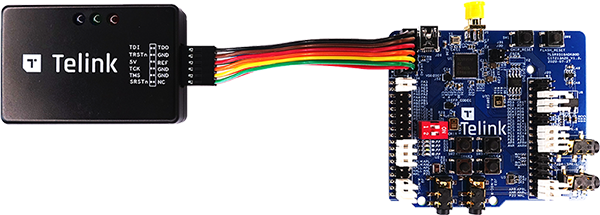Build and flash
Contents

Build and flash#
Pull docker image from repository:
$ docker pull connectedhomeip/chip-build-telink:latest
Run docker container:
$ docker run -it --rm -v ${CHIP_BASE}:/root/chip -v /dev/bus/usb:/dev/bus/usb --device-cgroup-rule "c 189:* rmw" connectedhomeip/chip-build-telink:latest
here
${CHIP_BASE}is directory which contains CHIP repo files !!!Pay attention that OUTPUT_DIR should contains ABSOLUTE path to output dirActivate the build environment:
$ source ./scripts/activate.sh
In the example dir run:
$ west build
Flash binary:
$ west flash --erase
Usage#
UART#
To get output from device, connect UART to following pins:
Name |
Pin |
|---|---|
RX |
PB3 (pin 17 of J34 connector) |
TX |
PB2 (pin 16 of J34 connector) |
GND |
GND |
LEDs#
Red LED indicates current state of Thread network. It ables to be in following states:
State |
Description |
|---|---|
Blinks with short pulses |
Device is not commissioned to Thread, Thread is disabled |
Blinls with frequent pulses |
Device is commissioned, Thread enabled. Device trying to JOIN thread network |
Blinks with whde pulses |
Device commissioned and joined to thread network as CHILD |
CHIP tool commands#
Build chip-tool cli
Pair with device
${CHIP_TOOL_DIR}/chip-tool pairing code ${NODE_ID_TO_ASSIGN} MT:D8XA0CQM00KA0648G00here:
${NODE_ID_TO_ASSIGN} is the node id to assign to the ota requestor
OTA with Linux OTA Provider#
OTA feature enabled by default only for ota-requestor-app example. To enable OTA feature for another Telink example:
set CONFIG_CHIP_OTA_REQUESTOR=y in corresponding “prj.conf” configuration file.
remove “boards/tlsr9518adk80d.overlay” file to enable 2MB flash storage.
After build application with enabled OTA feature, use next binary files:
zephyr_final.bin - main binary to flash PCB (Use 2MB PCB).
zephyr-ota.bin - binary for OTA Provider
zephyr.bin - ignore this file.
zephyr.signed.bin - ignore this file.
Usage of OTA:
Build the Linux OTA Provider
./scripts/examples/gn_build_example.sh examples/ota-provider-app/linux out/ota-provider-app chip_config_network_layer_ble=false
Run the Linux OTA Provider with OTA image.
./chip-ota-provider-app -f zephyr-ota.bin
Provision the Linux OTA Provider using chip-tool
./chip-tool pairing onnetwork ${OTA_PROVIDER_NODE_ID} 20202021here:
${OTA_PROVIDER_NODE_ID} is the node id of Linux OTA Provider
Configure the ACL of the ota-provider-app to allow access
./chip-tool accesscontrol write acl '[{"fabricIndex": 1, "privilege": 5, "authMode": 2, "subjects": [112233], "targets": null}, {"fabricIndex": 1, "privilege": 3, "authMode": 2, "subjects": null, "targets": null}]' ${OTA_PROVIDER_NODE_ID} 0here:
${OTA_PROVIDER_NODE_ID} is the node id of Linux OTA Provider
Use the chip-tool to announce the ota-provider-app to start the OTA process
./chip-tool otasoftwareupdaterequestor announce-ota-provider ${OTA_PROVIDER_NODE_ID} 0 0 0 ${DEVICE_NODE_ID} 0here:
${OTA_PROVIDER_NODE_ID} is the node id of Linux OTA Provider
${DEVICE_NODE_ID} is the node id of paired device
Once the transfer is complete, OTA requestor sends ApplyUpdateRequest command to OTA provider for applying the image. Device will restart on successful application of OTA image.
